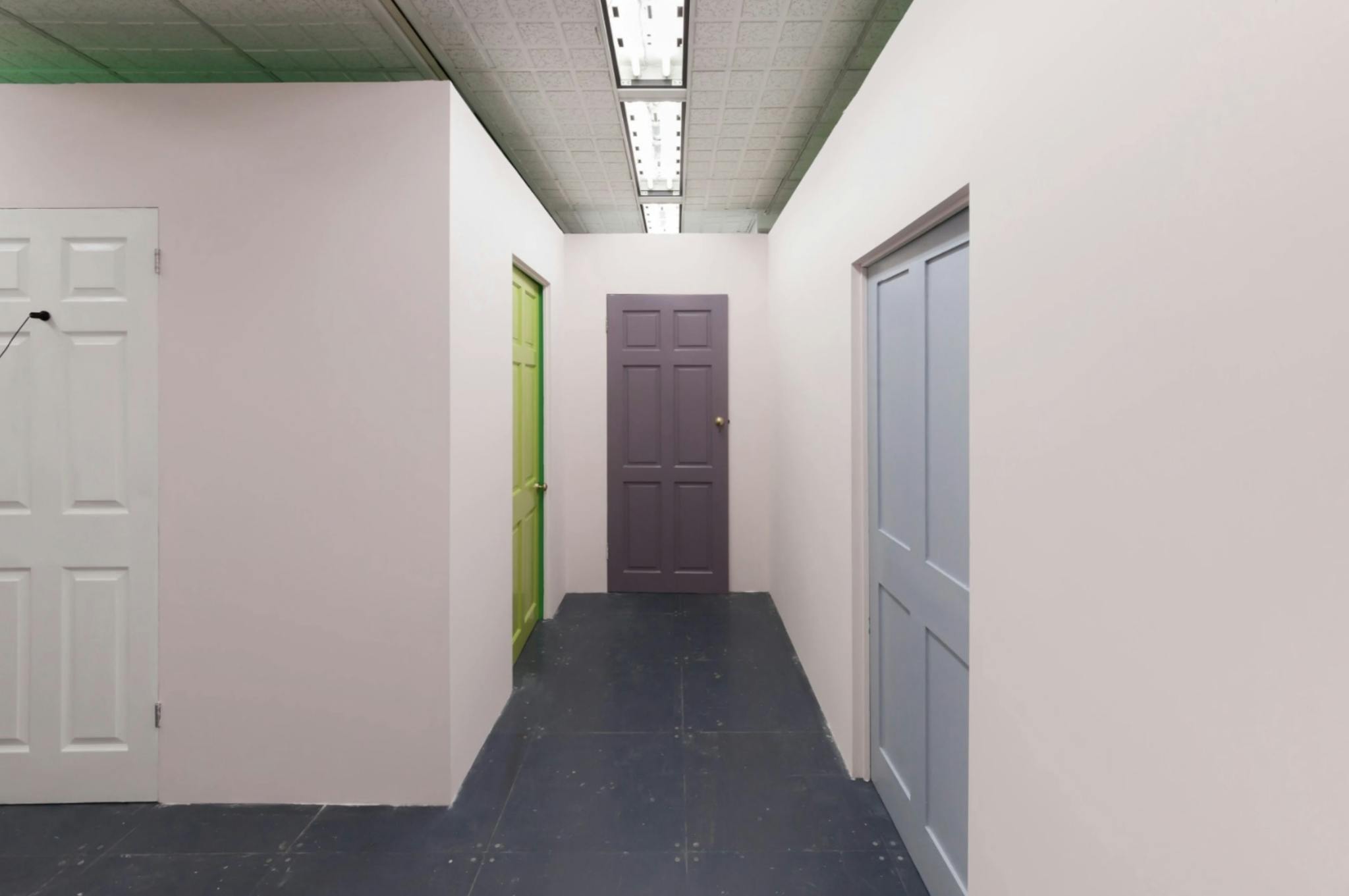Review: Morag Keil, Here We Go Again at Project Native Informant, London
September 2018

Morag Keil is not going to hold your hand. There is zero contextual information in the gallery for her show, aside from the title "Here We Go Again' written on the wall in a dripping green slime typeface, along with the artist's name in flesh pink and a big black number two. The suggestion is that the Scottish artist's second show at Project Native Informant-reached after clambering up three flights of stairs, the building's lift being out of order-equates to a horror movie sequel. (Keil likes this kind of pop-cultural conceit: a 2016 Berlin show entitled 'passive aggressive' was followed in 2017 by a New York show entitled 'passive aggressive 2:) On PNI's website, meanwhile, there's just an overhead view of a warren of rooms that zooms in and out; and this, in physical form, turns out to be what you encounter. Keil has built a series of cramped corridors and stark rooms behind cheap doors, some locked- a little brass doorknob came off in my hand- and others not, though the open ones don't deliver closure.
The corridors are painted either the same green as the title or the pink of the name; continuing this binary scheme are a pair of uplighters, which glow-again, like sconces in a horror movie-as you pass. The green walls might immediately remind you of a green-screen background, so that content can be pasted on later, blurring real and artificial; the pink, contrasted with this, is a clear cipher for the human. How our increasingly digitised experience nevertheless bumps up continually against raw physicality has been Keil's core concern for years: her Cubitt show in 2013, for instance, involved a cheap Dell workstation streaming a film concerning message-board comments and selling images to adult websites. Here, screens recur. Trying doors, you walk into one little space and see a monitor that plays a fragmentary view of somewhere you've already seen: the stairway directly outside the gallery, with its brass handrail. The camera moves within this space as in a first-person-shooter videogame. "Walk through the door, a voice instructs. "Walk five steps. You're not playing, though; you're being lightly disenfranchised. Soon enough, the screen resolves to a circle, a glow moving around its circumference like a countdown, and then you're back in the real-life video game.
Another door, locked, features a peephole and emits sounds. "What would you like to have a conversation about?" a voice asks. It doesn't matter what you say, this isn't interactive. After a while it asks, are you still there?' Then it tells you that 'your account will be debited of 63 credits, and there's a noise sampled from a Nintendo Wii console. Look through the fisheye and you see, on another screen, textural stuff borrowed from TV: a fragment of a nature documentary, a sliver of a game show. The last room you can enter contains a third monitor, and if you stand in front of it a camera behind you films both you and the screen you're looking at, where the rear view of your head falls into endless recession in nested rectangles. It's pointedly disappointing, like the whole experience of Here We Go Again!
Not much art elects to be this aggressively deflating, to sculpt with anti-climax in this manner. What Keil is doing here is conflating a landscape out of the different quotidian zones many of us shuttle between -the office environment, the bland televisual, gamer space, mainstream cinema with its rote sequels-and proffering it as a kind of low-key, deeply circular purgatory. The pivotal issue, though, is whether this disappointment is itself disappointing. The show has a synoptic air: it says that we are being sold a shabby bill of goods, that technocratic thinking doesn't deliver on its hype. But probably the viewer already knows this from experience, which leaves Kell's work as a faintly obvious lament, a bleak burlesque. Against that, perhaps the gutsiest thing about this show is its containment of contemporary art, and even the artist's own practice, within the arena of dismay: as you leave, the number two painted on the wall begins to look like a rearing snake, perhaps preparing to bite its own tail. Still, the tail has some sting in it. As you descend the stairs-here we go again-your hand gripping the cold brassy rail that you wouldn't have noticed if you hadn't just seen it on screen, you're bodied anew, even if that body now feels vaguely like it's in a game, and gifted with a real sense of escape. And you start to wonder who broke the lift.
Martin Herbert is a writer based in Berlin.